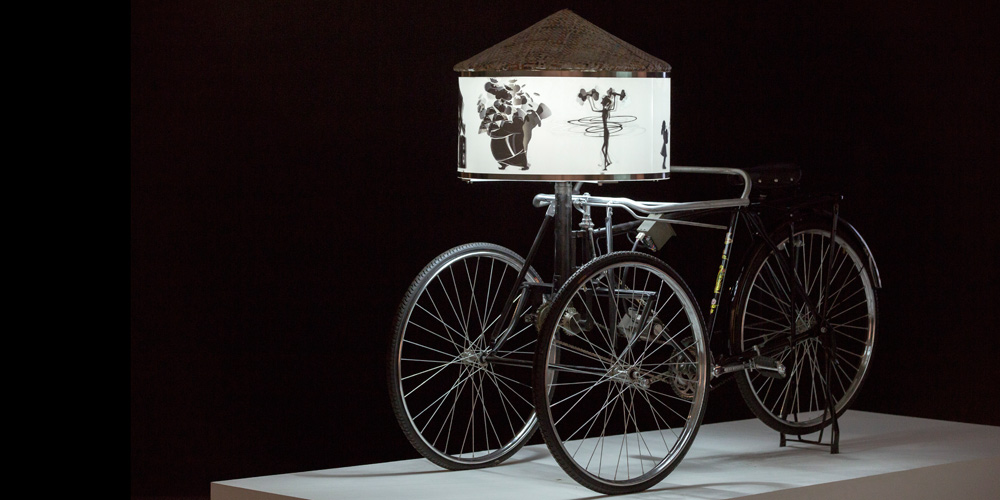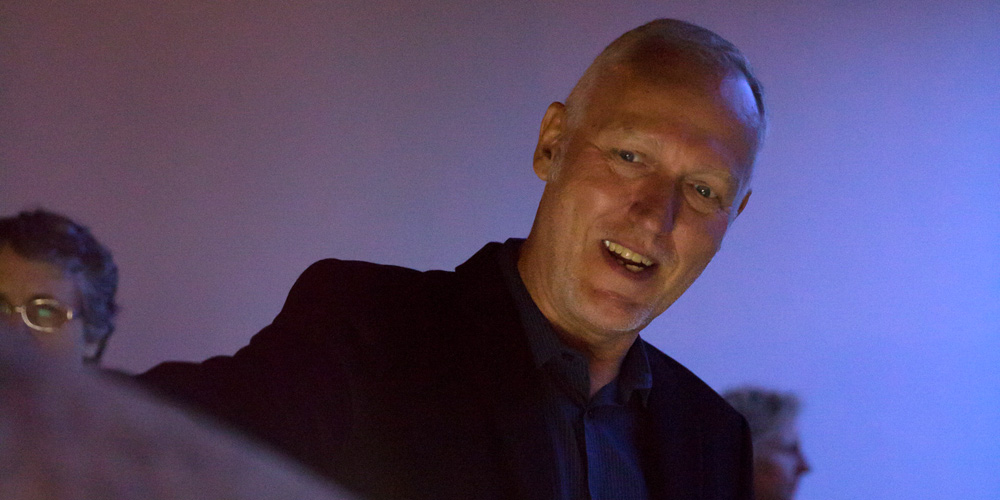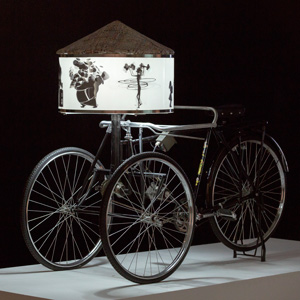
Photo: Vincent Ip
A bicycle in a media art exhibition? Scott Hessels, the creator of the “Lenticular Bicycle” which is part of the Device Art exhibition at the Ars Electronica Center, has a lot of stories to tell. But it’s rather the bicycle itself that let’s us think about our future energy consumption by looking back into a fake history.
Here at the Device Art exhibition you are presenting a “Lenticular Bicycle” – what’s that?
Scott Hessels: It is a bicycle that has been hacked into a mobile cinema machine. The “Lenticular Bicycle” is part of the series named “Sustainable Cinema” that consists of five kinetic sculptures that I have made. They all use natural energy like wind or water to create an optical illusion as if it was the beginning of cinema. If you go far but enough back in cinema history of the moving image celluloid film was made from cattle bones, pulp and powdered minerals, the screens were silk, the earlier you could find animal skins and wood fibres. So cinema actually started with organic natural power. Right away the industrial age and digital age came along and the use of nature disappeared. So I thought: What would have happened if cinema evolved from that origin? These machines are fake history machines – as if an old man would say: “I remember when movies were run on bicycles.”
You can look backwards at this fake history to think about more environmentally responsible ways of power and new devices. Looking backwards is one way to look forward.
[youtube=https://www.youtube.com/watch?v=iSwjzvDkTkU&w=610]
But you are also telling stories with your artwork…
Scott Hessels: This bicycle was made in a back allay in Shanghai using local metal workers and we bought the old parts of the bike from junkyards. The animation is lenticular which is also low-end. And it’s the story of all the things that people carry to their lives. You know the electronics, the act of shopping, as if the bicycle was a sort of laughing at us. But if you look at the cylindrical screen – the little girl is setting her burden free. The bicycle is pretty straight forward, it is fully functional, we are running it here on an electrical gear but you could get on it, put in your power and it would run completely by itself.

Photo: Tom Mesic
Why did you choose a bicycle as a device for your media art?
Scott Hessels: All of Southeast Asia bicycles are hacked into mobile businesses and it’s the transition between having a home-based business and a storefront. You modify a bicycle. I really found a beauty of that. The gear systems and so forth, they are all rough but there is so a nice brutish quality in it. Device Art is always very playful – here the machine becomes the message.
And artists are always rebellion. You can rebel in content, in what you say, or you can rebel in form, how you say it.
If you look through the Device Art exhibition all of this is a rebellion of form. Everyday objects are being inverted so that you look at it in a completely different social relationship. Here were have an ordinary bicycle but it makes you think about power systems and cinema history.

Photo: Tom Mesic
You are calling yourself a sculptor, media artist and filmmaker. What are you currently working on?
Scott Hessels: I run the program “Extreme Environments” at the School of Creative Media in Hong Kong. Last year in December a team of students from City University of Hong Kong trekked to Antarctica on an art and science research expedition to find new ways to understand climate change. This program takes students to endangered ecosystems – we use sensors to “read” the environment – and they return with a lot of data like images, videos and scientific datasets for creating new media artworks based on this data. It’s a very successful program in Hong Kong and it’s all about using the environment as a power source for media art.
The Device Art exhibition at the Ars Electronica Center will tun until the mid of 2015.
